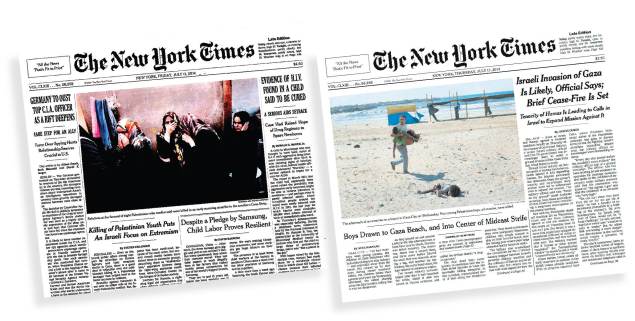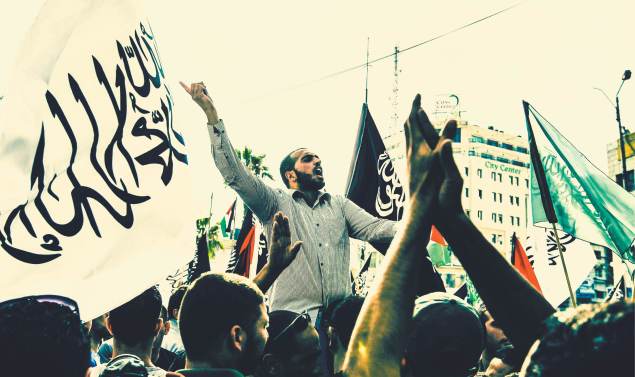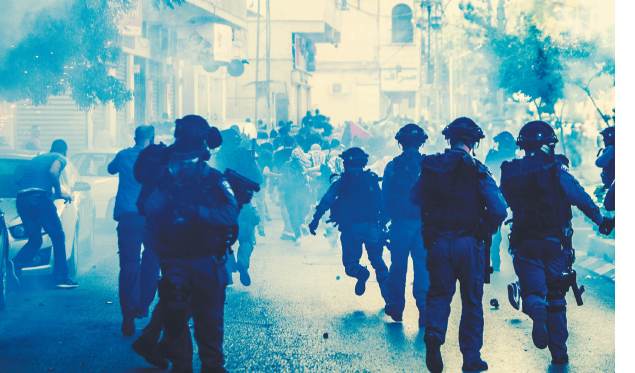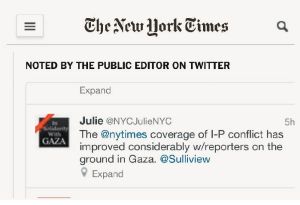
When Adolph S. Ochs purchased The New York Times in 1896 he pledged “intelligent discussion from all shades of opinion.” He bolstered his commitment with a new motto for the newspaper, promising: “All the News That’s Fit to Print.” But Ochs was also determined that the Times would never appear to be a “Jewish newspaper.” His pledges have competed for ascendancy ever since.
Arthur Hays Sulzberger, who succeeded his father-in-law as publisher in 1935, feared that Zionism would “exacerbate doubts about every Jew’s ultimate loyalty.” Editors were instructed not to refer to “the Jewish people” but to “the Jewish faith.” There was, he insisted, “no more reason to reconstitute the Jews as a nation than the Angles, the Celts or the Saxons.” A month before Israel declared independence Sulzberger lamented: “JEW is to be the common denominator for everything we do. God help us!”
The Times remains faithful to the Ochs-Sulzberger dogma. An unrelenting three-week Hamas missile assault against the Jewish state has recently been punctuated by tunnel invasions of Israeli territory, provoking a fierce Israeli air and ground response. But the Times has relentlessly pursued a story line of moral equivalency that equates Israeli retaliation with Hamas provocation.
Jerusalem bureau chief Jodi Rudoren led the way. Initially preoccupied with the Israeli “crackdown” in its desperate search for the likely Hamas murderers of three hitchhiking Israeli teenagers, which “raised questions about the asymmetry of the Israeli Palestinian conflict,” Ms. Rudoren was oblivious to the asymmetrical bias in her own reporting. On June 30, she wrote that Palestinians “see the act of attending yeshiva in a West Bank settlement as provocation.” It was Palestinian suffering, not the horrific murder of innocent Jews, that offended her moral sensibility—and compromised her journalistic objectivity.
So it was that the ghastly retaliatory kidnapping and murder of a Palestinian teenager provided the Times with a perfect opportunity for false moral equivalence. On July 7, Times editors erroneously accused Prime Minister Netanyahu of “days of near silence” in response to the killing of the Palestinian boy. Even its printed “Correction” for that glaring misstatement failed to note that Mr. Netanyahu had labeled the murder “reprehensible” on the day it occurred. The noxious Times editorial also erroneously converted Mr. Netanyahu’s quotation from a poem denouncing vengeance and vigilantism into a statement of approval. For that egregious error it offered no correction.

Two days later, on July 9, the Times lead Opinion column was entitled “A Palestinian Mother’s Fear in East Jerusalem.” Rula Salameh was understandably frightened by loud crashes and explosions outside her home: “We assumed these were rockets from Gaza.” Indeed they were. Rather than criticize, no less condemn, Hamas rocket attacks against civilian targets (including, ironically, Palestinian neighborhoods), she sadly pondered the fate of Gaza civilians who would “pay a heavy price for their leaders’ attempt to hit the Israeli seat of government” in Jerusalem.
Ms. Salameh recited the familiar litany that the Times finds so appealing that it cannot miss an opportunity to reiterate it in editorials, columns and news coverage: “The world must hold the Israeli government accountable for its actions,” most of all for “the entire occupation, whose violence and cruelty is the dark context for so much of what has happened over the past few weeks.”
But who will hold Hamas accountable for its actions, from kidnapping to murder to indiscriminate shelling of Israeli cities and towns? That question is of no interest—either to Ms. Salameh or, evidently, to the Times. It has yet to provide similar prominence for the expression of a Jewish mother’s fear as Hamas rockets explode nearby.
The Gaza war has provided the Times with a perfect opportunity, eagerly seized, to highlight Palestinian suffering. But Hamas’ cruelty to its own people is rarely noted. Recruits for martyrdom in the holy war against Israel are urged to gather on rooftops, instructed by their leaders to serve as human shields against Israeli retribution for 2,000 rockets that have been fired into the Jewish state during the past weeks. Beneath the rooftops are Hamas command centers and tunnels, where leaders take refuge and weapons are stored and fired. The benefit to Hamas from Palestinian civilian deaths is evident: Israel will be blamed.

It is no small irony that the Times blames Israel for what is a source of pride to Hamas. Spokesman Sami Abu Zuhri, ignored by the Times, declared: “This attests to the character of our noble, Jihad-fighting people who defend their rights and their homes with their bare chests and their blood.” As Jeffrey Goldberg observed (Bloomberg, July 11), “Hamas is trying to get Israel to kill as many Palestinians as possible.” Mr. Netanyahu told Fox News: “We’re using missile defense to protect our civilians, and they’re using civilians to protect their missiles.” The Times has carefully ignored that distinction.
Israel receives little credit for warning Gaza civilians to evacuate neighborhoods where Hamas fighters take refuge and rocket launchers are stored, often adjacent to—or inside—hospitals, mosques and schools. Reporting from Gaza City, Steven Erlanger and Isabel Kirshner interviewed fleeing Palestinians, gathered in a school building, who were eager to identify the current Hamas war against Israel as another Palestinian Nakba like the catastrophe of 1948 (when five Arab nations and Palestinian fighters waged a war to exterminate the fledgling Jewish state). No Times reporters were posted in Sderot in southern Israel, the constant target of Hamas rockets long before the current attacks began.
Neither combatant, reported the Times on July 13, was prepared to “signal interest in international appeals for a cease-fire as they continued their barrages.” In fact, Israel accepted the cease-fire that Hamas instantly rejected. On July 14, Times reporter Anne Barnard reported on Gaza families who are “financially and psychologically depleted” by the endless fighting. Israel is to blame, her Palestinian sources assert, for its continued “occupation” of Gaza—which ended nearly a decade ago.
The Israeli response, not the Hamas declaration of war, remains the centerpiece of moral equivalency in Times reporting, commentary and editorializing. |
Ms. Barnard devoted most of her article to the plight of a Palestinian woman whose family has been in flight whenever Hamas attacks Israel. But only Israeli “bombardments” and “assaults” receive attention. No reasons for the Israeli response are provided. Included, however, are the concluding words of praise from her Palestinian source for the “mujahedeen,” the holy warriors who “defend our people, ourselves, our land.”
The following evening Ms. Barnard joined three Arab men chatting under a date palm at a Gaza City café. “We have the right to defend ourselves against occupation,” one claimed. Another Gazan joined in the popular chant for Hamas rocket brigades: “Strike, strike Tel Aviv.” How this might play out in Tel Aviv went unrecorded. No Times journalist found it nearly as enticing a posting as Gaza City.
Times columnist Nicholas Kristof is the master of moral equivalency. His coverage of poverty, illness, and abuse in the underdeveloped world makes Gaza a magnetic attraction. It is “hard-liners on each side,” he wrote on July 16, “who are driving events.” To be sure, he concedes to Israel “a right to respond” to Gaza rockets—but only “with some proportionality”—a concept that he does not demand from Hamas.
Mr. Kristof holds Israel accountable for the current hostilities: after all, it “helped nurture Hamas.” Urging “a two-state peace agreement,” repeatedly rejected by Palestinians since 1937, his preferred model is Secretary of State John Kerry’s “admirable” peace initiative, which failed dismally. But Israel must impose a “halt to settlements” (during the last decade Israel has abandoned more settlements than it has built); cooperate with moderate Palestinian leader Mahmoud Abbas (who recently decided to partner with Hamas); and strengthen business development in Gaza (where rocket import and tunnel construction businesses have flourished). Only a “minimalist response” from Israel to unrelenting Hamas rocket attacks, defined by “tough-minded conciliation and restraint,” can end the conflict. He recommends no such constraints on Hamas.

The Times has yet to explore in any depth the location of Hamas missiles in civilian neighborhoods, in or near schools, hospitals and mosques, the better to call down wrath upon Israel for the civilian casualties that inevitably result from its retaliatory strikes. (Indeed, it has been revealed—not by the Times—that the United Nations Relief and Works Administration discovered rockets stored in a Gaza school.)
After nearly two weeks of nonstop rocket assaults, the Israel Defense Forces spotted armed Hamas terrorists exiting a tunnel inside Israel to attack a nearby kibbutz. Israel then launched a limited ground assault into Gaza to destroy the weapons sites. The Times response, co-written by Ms. Rudoren on July 18, predictably focused on the toll exacted on Palestinian civilians by Israeli retaliation. Conspicuously illustrating her account were mournful photos of Palestinians leaving their homes after Israeli tanks entered Gaza and injured Palestinian children being carried to a hospital. Hamas responsibility for the suffering of its people was ignored, except for a quote from Mr. Netanyahu.
The Times has
|
In a Times Opinion column published on July 17, just after the Israeli incursion into Gaza began, Nathan Thrall of the International Crisis Group claimed that the source of the current conflict was Israeli obstruction of the Palestinian consensus government, formed in early June, between Hamas and the Palestinian Authority. Israel’s refusal to ease its “suffering border closures” in Gaza, and its attempts to isolate the new government internationally, forced Hamas into “seeking through violence” what it could not obtain otherwise.
Two days later the lead Times editorial approvingly cited Mr. Thrall’s analysis. Conceding that Israel could not be expected to tolerate bombardment, for which “Hamas leaders deserve condemnation,” it still counseled Israel to pursue a peace agreement with the Palestinian Authority—which now partners with Hamas.
In a nearby Opinion column entitled “Faith-Based Fanatics,” Timothy Egan equated “the rage that moved Hamas to lob rockets on birthday parties in Tel Aviv, and Israelis to kill children playing soccer on the beach in Gaza.” In a disgraceful display of moral equivalence he blamed “extremists on both sides” for what Hamas intended and Israel did not.
On July 20, in its Sunday Review section, the Times provided further variations on that theme. Thomas Friedman, introducing a column on an entirely different subject, gratuitously bracketed “bad actors”—Hamas, Vladimir Putin and Israeli settlers—who are “trying to bury the future with the past and divide people.” Asking “Who’s Right and Wrong in the Middle East,” Mr. Kristof began with “Israeli troops again invading Gaza,” moving to “cross-demonization” by “two peoples who each have plenty of right.”

Mr. Kristof, who demonstrates his startling lack of knowledge about Israel whenever he writes about it, preposterously assigned special blame to “the Israeli right” for undermining the (non-existent) peace process. Israeli settlements, which have absolutely nothing to do with the current conflict except for providing three innocent teenagers who were kidnapped and murdered by Hamas agents, “are a gift to Palestinian extremism.” Mr. Kristof seems never to have learned that Palestinians have fought to destroy Israel since 1948, 20 years before the first settlement was built. In the end, for Mr. Kristof, it is “a conflict between right and right.” Rejecting “equivalence,” he prefers “symmetry”—between Hamas tyranny and Israeli democracy.
As the Gaza war reached a crescendo of violence on Sunday, the Times responded with its own surge of moral equivalency, shading inexorably into palpable anti-Israel bias. “Both Sides Engage in a Battle of Words,” headlined a report by Ms. Rudoren. But after a brief account of reciprocal insults in text messages and videos, she relied on “analysts” who conveniently turned out to be leftist Israeli writers David Grossman, Etgar Keret and Amos Elon, for whom Ha’aretz is the newest edition of the Hebrew Bible.
In its lead story, Ms. Barnard and Isabel Kershner skimmed quickly past the tunnels that transport Hamas fighters into Israeli territory in search of civilian and military targets. (The Times of Israel, not The New York Times, reported that 10 Hamas gunmen emerged from a tunnel opening inside a mosque.) Ms. Barnard wrote poignantly about the plight of Gaza civilians without mentioning Hamas responsibility for launching the rocket and tunnel attacks against Israel that are the cause of their hardship. The Israeli response, not the Hamas declaration of war, remains the centerpiece of moral equivalency in Times reporting, commentary and editorializing—and the difficulty a reader may encounter trying to distinguish one from the other.
Anyone with doubts about the veracity of Times coverage was invited in its Sunday Travel Section to participate in a “Times Journey” through “the geographical, cultural, historical and political landscapes of Israel and the West Bank,” to be led by a “featured expert.” That would be none other than Hanan Ashrawi, who happens to be a member of the PLO Executive Committee. On July 20, Ms. Ashrawi told ABC’s This Week that Israel committed “war crimes” in its “deliberate massacre” of Palestinian civilians. How likely is it that she will identify “the West Bank” as Judea and Samaria, the ancient homeland of the Jewish people?
Adolph Ochs and Arthur Hays Sulzberger would surely be pleased that unrelenting criticism of the Jewish state dominates all the news that’s fit to print. At the Times moral equivalence has become indistinguishable from moral blindness. Its editors and journalists might want to glance at the Hamas Charter, whose Preamble reads: “Israel will exist … until Islam will obliterate it.”
Jerold S. Auerbach is Professor Emeritus of History at Wellesley College. He is the author of 11 books, most recently Jewish State Pariah Nation: Israel and the Dilemmas of Legitimacy.

